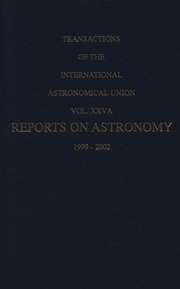No CrossRef data available.
Article contents
40. Radio Astronomy (Radio Astronomie)
Published online by Cambridge University Press: 25 April 2016
Extract
The following commission members have contributed to this report:
W.J. Altenhoff, H. Andernach, J. Baars, R. Chini, R.J. Cohen, J.J. Condon, Y. Fukui, R. Güsten, J.M. van der Hulst, C. Henkel, W. Huchtmeier, M. Ishiguro, T. Krichbaum, M, Kundu, A. Lazenby, W. Reich, P. Roelfsema, S.E. Thorsett, R. Tuffs, CM. Walmsley, H. Wendker, R. Wielebinski, T.L. Wilson (organizer), A. Witzel
Aperture Synthesis Telescopes - Commissioning tests and observations have been made using three antennas in the Australia Telescope (AT), spaced up to 2km apart, and the first image of a radio source observed at 6cm was produced in 1989. The IRAM millimeter array in France comprizing three 15-m antennas has been commissioned at 3mm. A fourth antenna is planned as well as operation at 1mm. The three element Berkeley-Illinois-Maryland Array (BIMA) at Hat Creek is being expanded to six 6-m antennas and a new correlator with 1024 channel up to 830MHz bandwidth. Plans to expand to 9 antennas are final. The Owens Valley three-element millimeter array has been operated at 1mm, the shortest wavelength for the radio interferometry; a digital correlator with 500MHz bandwidth is under construction and the array will be extended to 6 antennas. In Japan at NRO the Nobeyama Millimeter Array equipped with SIS receivers and 320MHz bandwidth "FX" correlator is now operational at 3mm and 7mm wavelengths. New SIS receivers for 1mm and 2mm are under construction and a sixth 10-m antenna is planned. The Cambridge 5-km telescope, now the Ryle Telescope, has been substantially upgraded. The overall sensitivity of the instrument is being increased by a factor of ~20. The Giant Metrewave Radio Telescope, being built at Khodad near Pune in India, has made considerable progress and is expected to be operational by 1992-93.
- Type
- Research Article
- Information
- Copyright
- Copyright © Kluwer 1991


